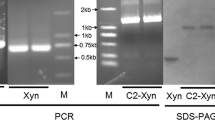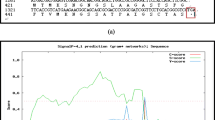Abstract
Xylanases are very often modular enzymes composed of one or more catalytic domains and carbohydrate-binding modules (CBMs) connected by a flexible linker region. Usually, when these proteins are processed they lose their carbohydrate-binding capacity. Here, the role of the linker regions and cellulose- or xylan-binding domains in the processing of Xys1L from Streptomyces halstedii JM8 and Xyl30L from Streptomyces avermitilis UAH30 was studied. Xys1 variants with different linker lengths were tested, these being unable to avoid protein processing. Moreover, several fusion proteins between the Xys1 and Xyl30 domains were obtained and their proteolytic stability was studied. We demonstrate that CBM processing takes place even in the complete absence of the linker sequence. We also show that the specific carbohydrate module determines this cleavage in the proteins studied.





Similar content being viewed by others
References
Adham SA, Honrubia P, Díaz M, Fernández-Ábalos JM, Santamaría RI, Gil JA (2001) Expression of the genes coding for the xylanase Xys1 and the cellulase cel1 from the straw-decomposing Streptomyces halstedii JM8 cloned into the amino-acid producer Brevibacterium lactofermentum ATCC13869. Arch Microbiol 177:91–97
Bajpai P (1999) Application of enzymes in the pulp and paper industry. Biotechnol Prog 15:147–157
Beg QK, Bhushan B, Kapoor M, Hoondal GS (2000) Enhanced production of a thermostable xylanase from Streptomyces sp. QG-11–3 and its application in biobleaching of eucalyptus kraft pulp. Enzyme Microb Technol 27:459–466
Beg QK, Kapoor M, Mahajan L, Hoondal GS (2001) Microbial xylanases and their industrial applications: a review. Appl Microbiol Biotechnol 56:326–338
Bernfeld P (1951) Enzymes of starch degradation and synthesis. In: Nord FF (ed) Advances in enzymology, vol XII. Interscience, New York, pp 379–428
Biely P, Mislovicova D, Toman R (1985) Soluble chromogenic substrates for the assay of endo-1,4-β-xylanases and endo-1,4-β-glucanases. Anal Biochem 144:142–146
Black GW, Rixon JE, Clarke JH, Hazlewood GP, Ferreira LM, Bolam DN, Gilbert HJ (1997) Cellulose binding domains and linker sequences potentiate the activity of hemicellulases against complex substrates. J Biotechnol 57:59–69
Canals A, Vega MC, Gomis-Rüth FX, Díaz M, Santamaría RI, Coll M (2003) Structure of xylanase Xys1∆ from Streptomyces halstedii. Acta Crystallogr D59:1447–1453
Collins T, Gerday C, Feller G (2005) Xylanases, xylanase families and extremophilic xylanases. FEMS Microbiol Rev 29:3–23
Fernández-Abalos JM, Reviejo V, Díaz M, Rodríguez S, Leal F, Santamaría RI (2003) Posttranslational processing of the xylanase Xys1L from Streptomyces halstedii JM8 is carried out by secreted serine proteases. Microbiology 149:1623–1632
Hanahan D (1983) Studies on transformation of Escherichia coli with plasmids. J Mol Biol 166:557–580
Hernández A, López JC, Santamaría R, Díaz M, Fernández-Ábalos JM, Copa-Patino JL, Soliveri J (2008) Xylan-binding xylanase Xyl30 from Streptomyces avermitilis: cloning, characterization, and overproduction in solid-state fermentation. Int Microbiol 11:133–141
Hopwood DA, Bibb JM, Chater KF, Kieser T, Bruton CJ, Kieser HM, Lydiate DJ, Smith CP, Ward JM, Schrempf H (1985) Genetic manipulation of Streptomyces: a laboratory manual. John Innes Foundation, Norwich
Kieser T, Hopwood DA, Bibb JM, Chater KF, Buttner MJ (2000) Practical Streptomyces genetics. John Innes Foundation, Norwich
Kittur FS, Mangala SL, Rus’d AA, Kitaoka M, Tsujibo H, Hayashi K (2003) Fusion of family 2b carbohydrate-binding module increases the catalytic activity of a xylanase from Thermotoga maritima to soluble xylan. FEBS Lett 549:147–151
Li N, Shi P, Yang P, Wang Y, Luo H, Bai Y, Zhou Z, Yao B (2009) A xylanase with high pH stability from Streptomyces sp. S27 and its carbohydrate-binding module with/without linker-region-truncated versions. Appl Microbiol Biotechnol 83:99–107
Lu P, Feng MG (2008) Bifunctional enhancement of a beta-glucanase-xylanase fusion enzyme by optimization of peptide linkers. Appl Microbiol Biotechnol 79:579–587
Mangala SL, Kittur FS, Nishimoto M, Sakka K, Ohmiya K, Kitaoka M, Hayashi K (2003) Fusion of family VI cellulose binding domains to Bacillus halodurans xylanase increases its catalytic activity and substrate-binding capacity to insoluble xylan. J Mol Catal B Enzym 21:221–230
Peterson GL (1977) A simplification of the protein assay method of Lowry et al. which is more generally applicable. Anal Biochem 83:346–356
Rodríguez S, Santamaría RI, Fernández-Ábalos JM, Díaz M (2005) Identification of the sequences involved in the glucose-repressed transcription of the Streptomyces halstedii JM8 xysA promoter. Gene 351:1–9
Ruiz-Arribas A, Fernández-Abalos JM, Garda AL, Sánchez P, Santamaría RI (1995) Overproduction, purification and biochemical characterization of one xylanase (Xys1) from Streptomyces halstedii JM8. Appl Environ Microbiol 61:2414–2419
Ruiz-Arribas A, Sanchez P, Calvete JJ, Raida M, Fernandez-Abalos JM, Santamaria RI (1997) Analysis of xysA, a gene from Streptomyces halstedii JM8 that encodes a 45-kilodalton modular xylanase, Xys1. Appl Environ Microbiol 63:2983–2988
Sambrook J, Fritsch E, Maniatis T (1989) Molecular cloning: a laboratory manual, 2nd edn edn. Cold Spring Harbor Laboratory, Cold Spring Harbor
Acknowledgments
This work was supported by grant CSI02A05 from the “Junta de Castilla y León” to R. Santamaría. Thanks are also due to MJ Jiménez Rufo for her excellent technical work, and to N. Skinner for supervising the English version of the manuscript.
Author information
Authors and Affiliations
Corresponding author
Electronic supplementary material
Below is the link to the electronic supplementary material.
Rights and permissions
About this article
Cite this article
Díaz, M., Fernández-Ábalos, J.M., Soliveri, J. et al. Post-translational processing of modular xylanases from Streptomyces is dependent on the carbohydrate-binding module. J Ind Microbiol Biotechnol 38, 1419–1426 (2011). https://doi.org/10.1007/s10295-010-0927-y
Received:
Accepted:
Published:
Issue Date:
DOI: https://doi.org/10.1007/s10295-010-0927-y




